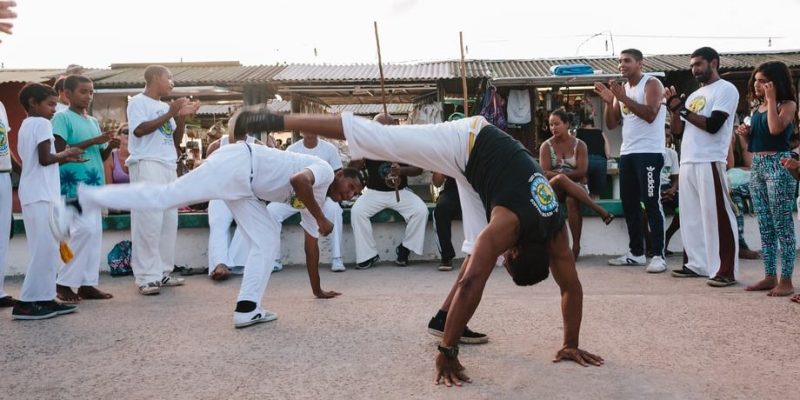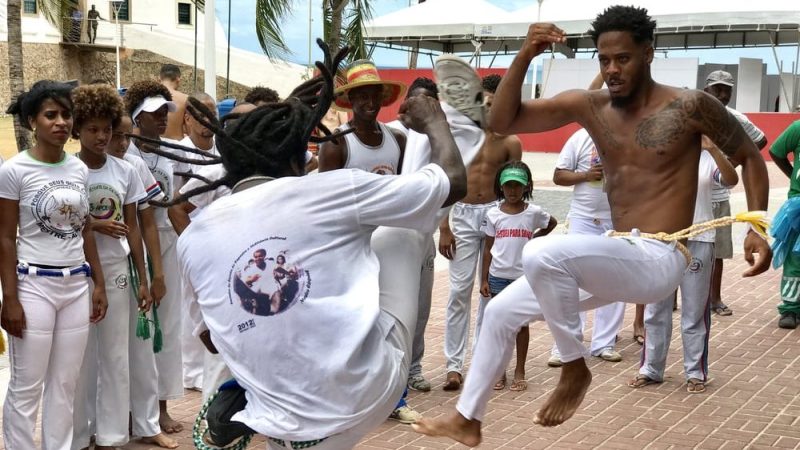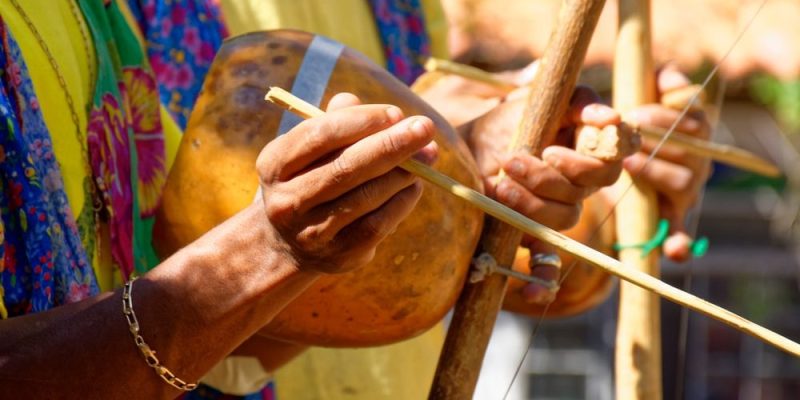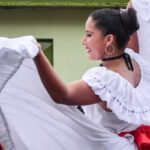We explain what capoeira is, its origin, history and characteristics. In addition, we tell you what musical instruments he uses.

What is capoeira?
capoeira is a form of Brazilian cultural expression with African roots, in which different disciplines are combined such as dance martial arts, music and acrobatics. It is usually practiced in groups, organized in Rhodes or circles, to the beat of drum music and other traditional instruments such as the birimbao, accompanied by singing. Since 2014, UNESCO considers the capoeira circle as part of the intangible cultural heritage of humanity.
The practice of capoeira is colorful and It is part of the Afro-Brazilian cultural heritage, especially from the northeast region of the country. The capoeira session is called game (“game”) and most of the time it consists of a symbolic fight with little or no physical contact between the participants, who simulate the blows. Other times it is limited to a choreography in which talent or mandinka (magical or spiritual power that comes from nature). There can also be real fighting sessions, quite intense. In all cases, the tenor of the confrontation is marked by the rhythm of music and singing.
There are different variants of capoeira. The main ones are regional capoeira, more modern and acrobatic; capoeira angola, more traditional and with greater emphasis on body dialogue; and contemporary capoeira, a fusion of the previous two.
As with other martial arts, usually The teaching of capoeira is accompanied by the transmission of values such as respect, responsibility, trust, sagacity and freedom.
Currently, capoeira is practiced not only in Brazil, but throughout the world, through academies or specialized groups. Countries such as Germany, Italy, the United States, Argentina, Mexico, New Zealand and even China have communities and/or practice centers in their main cities.
Origin of the term: The term capoeira It has an uncertain origin. Some scholars affirm that the word could come from Tupi-Guaraní, while others associate it with African terms used by slaves brought to America or attribute it to a spontaneous form that would have emerged among them.
Origin and history of capoeira
The exact origins of capoeira are unknown. It is presumed that It was an invention of enslaved African settlers in Brazil in the 16th century many of whom belonged to the Bantu (Kongo, Kimbunda and Kasanje), Hausa, Akan, Igbo, Yoruba, Dahomey and Guinean ethnic groups, coming from Angola, Congo and Mozambique. Dance costume ritual capoeira allowed slaves to train for fighting and, at the same time, link together and strengthen ties between residents of different origins.
Once slavery was abolished, capoeira continued to be practiced among the descendants of African slaves. Due to the racist considerations of the time, it was associated with the criminal world and witchcraft, which is why It was banned throughout Brazilian territory in 1890. Systematic efforts to eradicate its practice reached extremes of cruelty such as torture and physical punishment, but even so it continued to be practiced clandestinely.
In this sense, the calls were fundamental quilombosself-sufficient settlements of runaway slaves that had organized to face the European threat. In the quilomboscapoeira could be practiced freely.
After a long period of persecution, In the first decades of the 20th century, capoeira resurfaced thanks to the interest of martial arts researchers, like Mario Alexo and Aníbal “Zuma” Burlamaqui. The latter published around 1920 the first manual for the practice of capoeira and the first formal rules of competition, many inspired by boxing.
Another cultist of special importance was Agenor Moreira Sampaio, better known as Mestre Sinhozinho, who developed the Carioca style (now extinct) and is considered one of the great masters of capoeira, along with Mestre Bimba (Manoel dos Reis Machado) and Mestre Pastinha. (Vicente Ferreira Pastinha). These great masters were the first to open academies for teaching capoeira around the middle of the 20th century.
Characteristics of capoeira

Broadly speaking, capoeira is characterized by the following:
- Combines martial arts, dance, music and acrobatics. Capoeira is a discipline that uniquely fuses the characteristics of martial arts (physical, mental and philosophical training) with dance.
- It is an African heritage The movements, musical rhythms and instruments of capoeira show the cultural legacy of the Congo, Mozambique and Angola, countries where the African settlers of Brazil came from.
- It is practiced in circles or Rhodes. Capoeira is practiced in circles made up of capoeiristas, in the center of which the duel between two dancers takes place. The rest accompanies them with clapping, singing and the sound of traditional musical instruments, such as drums and the birimbao.
- Its purpose is to display skills. The objective of this art is not to hurt the opponent, but to compare the talents of the participants through a dialogue of movements guided by principles of respect, responsibility, trust, sagacity and freedom. It also seeks to honor a cultural heritage of centuries. For this reason, blows are often not carried out, but are simply demonstrated.
Capoeira movements are divided into three types:
- The ginga or swing. It is a continuous and basic step from which the other movements are carried out.
- The attacks. They can consist of kicks, sweeps, blows with the open hand or head.
- The defenses. They are evasive movements and blocks.
capoeira styles
Capoeira is not practiced in the same way everywhere, but has different styles, each with particularities and preferences. Some capoeiristas, for example, do not use hand strikes, others focus on the acrobatic aspect and others tend towards the more traditional. The main known styles are the following:
capoeira angola
Capoeira Angola is considered the original style of capoeira, that is, the most traditional. It is characterized by a dance of greater proximity between the campoeirantes, little acrobatic and many low movements, that is, at ground level. This style depends a lot on the skill of the dancer. The music usually starts slowly and increases as the fight progresses. The creator of the Angola capoeira academies in Brazil was Mestre Pastinha, who institutionalized the yellow, black or white (ceremonial) uniform.
regional capoeira
Regional capoeira was an innovative style, with greater emphasis on acrobatics and more colorful dances. Originally, it was called the “Bahia regional fight.” (A regional mourning of Bahia). Its creator and promoter in Brazil was Mestre Bimba, who opted for a more athletic and competitive style, with quick and dry blows. The regional capoeira uniform includes a belt that reflects the level of training of the capoeirista, in the manner of oriental martial arts.
contemporary capoeira
The name contemporary capoeiristas identifies those who practice both traditional and regional styles and freely fuse their elements. These practitioners can take what they like from the style of Mestre Bimba or Mestre Pastinha without fully committing to either, but rather using them in a complementary way.
Music in capoeira

Music is a central element in the practice of capoeira. Through his traditional instruments, he sets the rhythm, intensity and atmosphere of combat and dance. The main instruments used in capoeira are:
- Birimbao. It is a bow-shaped string instrument, made with a flexible wooden stick and a metal wire, with a dry, empty gourd that functions as a resonator. Depending on the tension of the bow, the sound produced can be low, medium or high-pitched.
- Pandeiro. It is a percussion instrument very similar to the tambourine, but larger.
- Querequeté or querequexé. It is a scraping instrument, also called reco-reco either caracaxa. It is usually made of materials such as bamboo or other woods, metal or gourd. It can have different shapes or motifs and is scraped with a short wooden stick.
- Agogo. It is a percussion instrument made of metal, similar to a bell or gong, which is struck with a short wooden baton.
- Atabaque. It is a percussion instrument very similar to the hand drum, tall and wooden, which is played with the hands.
References
- Almeida, B. (1986). Capoeira, a Brazilian Art Form. History, Philosophy, and Practice. North Atlantic.
- Torres Negro, L. (2000). Capoeira, martial art from Brazil. At.
- UNESCO. (2020). The capoeira circle. https://ich.unesco.org/es/





